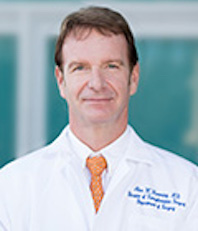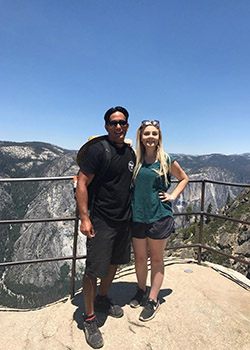Living Donor Liver Transplant
August 10, 2017 | Lindsay Morgan
Almost 4 million adults in the United States are living with liver disease, and chronic liver disease and cirrhosis is the 9 th leading cause of death in California (2015), with nearly 5,500 deaths in 2015 alone.
Liver failure typically develops slowly as the result of repetitive liver damage from hepatitis C, or other forms of chronic hepatitis, including hepatitis B and autoimmune hepatitis; alcoholism; primary biliary cirrhosis (PBC); metabolic and other disorders. A small number of patients suffer from acute liver failure, which is the rapid loss of liver function in a person who has no pre-existing liver disease.
Liver failure can be treated through liver transplantation; in fact, liver transplantation is the second most common form of organ transplant after kidney transplant. Since 1988, there have been 151,895 liver transplants in the United States, and the procedure is performed at approximately 100 centers in the U.S. About 70 percent of people who undergo liver transplant live for at least five years.
Despite progress, the supply of livers from non-living donors is far short of the need. More than 15,000 people are currently waiting for a liver transplant, and though approximately 6,300 people receive a liver transplant each year, at least 1,400 people die waiting. With livers allocated on the basis of the "sickest first" principal, the majority of patients in California are hospital-bound and often in the ICU after lengthy illness prior to receiving a liver. In California, 20-25% of people waiting for a liver transplant will die each year.
Living donor liver transplantation
The large mismatch in available organs versus those needing transplant has spurred the development of living donor liver transplantation (LDLT), wherein a piece of healthy liver is surgically removed from a living person and transplanted into a recipient immediately after the recipient's diseased liver has been entirely removed. The liver is the only organ in the human body that can regenerate and both the donor and recipient portion of the liver will regenerate to 80% of the original liver size within eight weeks.
The first successful LDLT was performed in Australia in 1989, from a mother to her son, with a graft survival of 14 months and no donor morbidity. Since then, there have been a total of 6,202 living donor liver transplants in the United States, 938 of which have taken place in California. The majority of these were adult-to-child, which require only a small portion of the adult liver. With the increasing need for, and the development of improved surgical techniques, adult-to-adult live donor liver transplant has been developed wherein the entire left lobe (40-45% of the liver) or more commonly right lobe (60% of the liver) is used.
Of the nine adult liver transplant programs in California, only four centers have performed adult-to-adult living donor liver transplant procedures in the last three years, with UCSD the only live donor liver transplantation program in San Diego.
The success rate of LDLT for recipients is approximately 90%, which is similar to that of patients receiving whole-organ, deceased-donor livers. Among the benefits of LDLT is the early access to transplant, which allows patients to be transplanted prior to the lengthy deterioration in health that occurs while waiting for a deceased-donor liver to become available. LDLT also allows transplantation while patients are less critically ill and better able to recover from the demanding process of liver transplantation.
UCSD's Living Donor Liver Transplant Program
UC San Diego Health surgeons are the only team currently performing LDLT in San Diego and have performed 9 of these procedures since 2015, with a success rate of 90%.
 Alan Hemming, MD, professor of surgery in the Department of Surgery and chief of the Division of Transplantation and Hepatobiliary Surgery, manages the program and conducts all of the living donor operations. Live donation requires two simultaneous surgical teams—one for the donor and one for the recipient—so the entire surgical group is involved.
Alan Hemming, MD, professor of surgery in the Department of Surgery and chief of the Division of Transplantation and Hepatobiliary Surgery, manages the program and conducts all of the living donor operations. Live donation requires two simultaneous surgical teams—one for the donor and one for the recipient—so the entire surgical group is involved.
Dr. Hemming was involved in his first LDLT at the University of Toronto, before becoming the Chief of Transplantation and Hepatobiliary Surgery at the University of Florida, where he developed one of the nation's fastest growing treatment centers for hepatobiliary disease, and also performed LDLT. Under his leadership, the program's surgeons were able to aggressively resect and cure up to a third of patients who had been identified as unresectable by other institutions.
 Since joining UCSD in 2010, Hemming has launched the adult LDLT program; developed and expanded the program for primary and metastatic liver cancer to include cases that were previously unresectable; performed the first ex vivo liver resection in California; and expanded a clinical research program to explore new technologies and their application to liver surgery.
Since joining UCSD in 2010, Hemming has launched the adult LDLT program; developed and expanded the program for primary and metastatic liver cancer to include cases that were previously unresectable; performed the first ex vivo liver resection in California; and expanded a clinical research program to explore new technologies and their application to liver surgery.
"Liver transplantation is the victim of its own success," says Hemming. "Initial successes have broadened the application of the surgery and expanded the need—well past the availability of deceased donor organs. Live donor liver transplantation, though technically demanding and carrying some risk for the donor, allows more lives to be saved."
Photo: Ashley (liver recipient) and Keith, her uncle (the donor) hiking in Yosemite.
